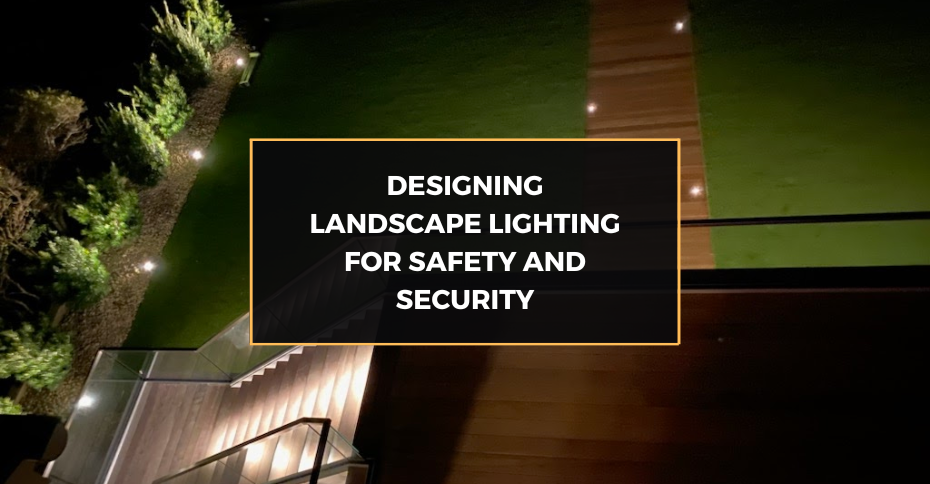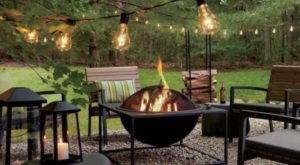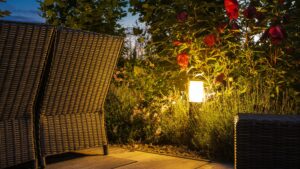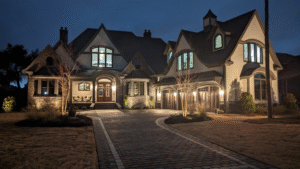Understanding the Basics of Landscape Lighting
Designing landscape lighting for safety and security begins with a fundamental understanding of how light affects our perception of space. Designing landscape lighting effectively can transform an ordinary outdoor area into a secure and inviting environment.
The Role of Lighting in Security
Landscape lighting is a critical element in home security. Adequate illumination can significantly deter intruders by removing potential hiding spots and enhancing visibility around the property. It’s essential to balance the light distribution, focusing on vulnerable areas like windows and doors. This involves avoiding excessive brightness that can create glare and blind spots, thus compromising security. Ideal lighting should provide a clear view of these areas without casting harsh shadows or being overly intrusive to neighbors.
Choosing the Right Brightness and Color Temperature
When designing landscape lighting selecting appropriate brightness levels is vital in avoiding under or over-lit spaces. Lights that are too bright can create deep shadows in unlit areas, potentially offering hiding spots. Conversely, dim lights may not provide sufficient visibility for security. The color temperature of the lights also plays a role in the ambiance and perception of safety. Warmer lights create a welcoming atmosphere but may not be as effective for security purposes. Cooler, brighter lights are often recommended for security, as they provide clearer visibility and can better deter potential intruders.
Strategic Placement of Landscape Lights
Strategically placing and designing landscape lighting can significantly enhance the safety and aesthetic appeal of a property. Lighting should be used to highlight landscaping features while providing adequate illumination for navigation.
Illuminating Entry Points and Pathway
Ensuring that all potential entry points are well-lit is crucial for security. This includes not just front doors but also side entrances, back doors, and windows. Pathway lighting should provide clear, consistent illumination to prevent accidents and guide visitors.
Types of Security Lights for Optimal Safety
When designing landscape lighting to enhance home safety and security the choice of light fixtures is paramount. A variety of lighting types can be employed, each serving a specific purpose and contributing to the overall security of the property.
Motion-Sensor Lights: A Smart Choice
Motion-sensor lights are excellent for security purposes. They activate only when movement is detected, saving energy and surprising potential intruders. These lights are ideal for less frequented areas of the property.
Floodlights for Wide Area Coverage
Floodlights are designed to illuminate large areas with a broad beam of light. They are perfect for open spaces like yards and driveways, ensuring no dark corners are left unlit.
Integration of Landscape Lighting with Other Security Measures
Designing landscape lighting to integrate with other security measures can create a more robust security system.
Synchronizing Lights with Security Systems
Integrating landscape lighting with security systems enhances a property’s safety greatly. This integration involves connecting outdoor lighting with alarms and surveillance cameras, creating a cohesive security network. For example, lights can be programmed to turn on when a security camera detects movement, or when an alarm is triggered, thereby deterring intruders and alerting homeowners to potential security breaches. This synergy not only increases the effectiveness of each individual component but also provides a comprehensive security solution that covers all bases.
Smart Lighting Solutions for Enhanced Control
Smart lighting technology revolutionizes how homeowners interact with their outdoor lighting systems. These advanced systems allow for remote control via smartphones or tablets, enabling users to adjust lighting settings from anywhere, at any time. Homeowners can program lighting scenarios for different times of the day or for specific events, such as having all lights turn on at full brightness when motion is detected after dark. The flexibility offered by smart lighting extends beyond convenience; it also provides an enhanced security layer by allowing homeowners to simulate presence even when they are away, thereby deterring potential intruders.
Maintaining Your Landscape Lighting for Optimal Performance
Regular maintenance of landscape lighting is essential for ensuring ongoing performance and security.
Routine Checks and Maintenance
To ensure that landscape lighting continues to function as intended, regular maintenance is essential. This involves periodic inspections to check for and rectify any exposed or damaged wiring, cleaning fixtures to prevent dirt and debris accumulation, and replacing any burnt-out or dimming bulbs. Homeowners should also periodically adjust the positioning of lights to compensate for changes in the landscape, such as plant growth. These routine checks not only extend the lifespan of the lighting system but also ensure that it remains effective in illuminating the property and enhancing security.
Addressing Common Lighting Issues
Effective maintenance also involves promptly addressing common issues that may arise with landscape lighting. One frequent problem is bulb burnout, which can compromise the security and aesthetic appeal of the outdoor space. Regularly checking and replacing bulbs can prevent this issue. Wiring problems, such as frayed or chewed wires (often caused by rodents or weather), can pose safety hazards and should be addressed immediately. Sensor malfunctions in motion-activated lights are another common issue; these typically require recalibration or, in some cases, replacement of the sensor unit. By staying vigilant and addressing these issues promptly, homeowners can ensure that their landscape lighting remains a reliable component of their overall security strategy.
Our Approach to Security Lighting
We specialize in designing landscape lighting and installations that enhance both the security and beauty of your property. Our expert team understands the importance of strategic placement, optimal brightness, and designing landscape lighting to meet your security needs.
Integrating Style with Security
Our philosophy is that security lighting should not only be functional but also aesthetically pleasing. We believe in blending security features seamlessly with the overall design of your property. Our team carefully selects fixtures and lighting styles that enhance the architectural beauty of your space while providing the necessary level of security. This approach ensures that our lighting solutions are not just protective measures, but also add value and appeal to your property. Our team works closely with clients to ensure every installation meets their specific requirements and exceeds expectations.
FAQs
Can I install landscape lighting myself, or do I need a professional?
While some simpler systems can be DIY projects, designing landscape lighting and complex installations, especially those involving electrical work, are best done by professionals to ensure safety and optimal functionality.What are the best techniques to conceal security lights without compromising their effectiveness?
Concealing security lights can involve using landscaping elements like bushes or decorative covers that blend with the environment but still allow the light to cover key areas effectively.Can security lights be too bright, and what are the implications?
Excessively bright security lights can cause glare, create deep shadows where intruders can hide, and be intrusive to neighbors. It’s important to balance brightness for optimal security and comfort.Is it better to have fewer powerful lights or multiple less-intense lights for security?
Multiple less-intense lights are generally better as they reduce harsh shadows and cover more area, making it harder for intruders to find hiding spots.What are the best practices for lighting up perimeter walls and fences for security?
Designing landscape lighting for perimeter walls and fences involves positioning lights at regular intervals and angles that cover the entire length without creating blind spots or shadows.






